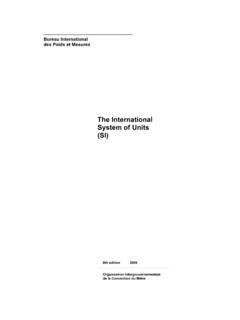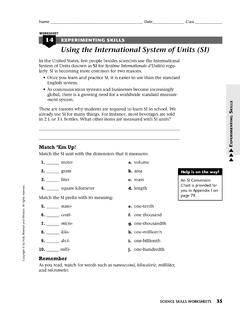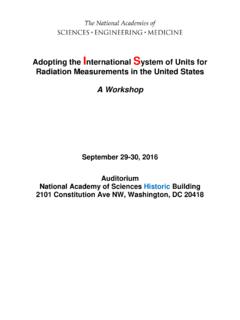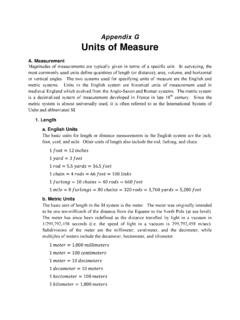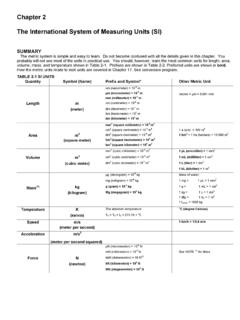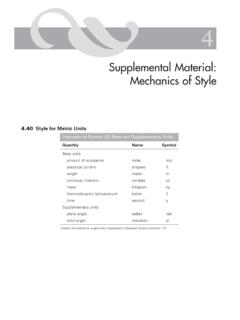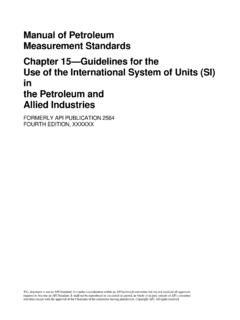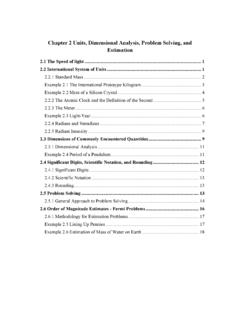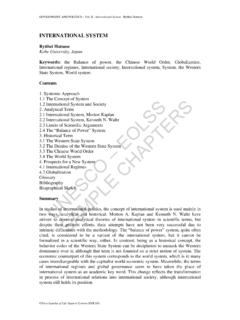Transcription of Practical Guide to the International System of Units (SI)
1 Table 1 Prefixes Symbol Prefix Factor Y yotta 1024 Z zetta 1021 E exa 1018 P peta 1015 T tera 1012 G giga 109 M mega 106 k kilo 103 h hecto 102 da deka 101 100 = 1 d deci 10 1 c centi 10 2 m milli 10 3 ( micro 10 6 n nano 10 9 p pico 10 12 f femto 10 15 a atto 10 18 z zepto 10 21 y yocto 10 24 Table 2 SI Units Symbol unit Name Quantity (general symbol) Definition General Purpose m meter length (l) BASE unit kg kilogram mass (m) BASE unit s second time (t) BASE unit K kelvin temperature (T) BASE unit m square meter area (A) m m cubic meter volume (V) m N newton force (F) kg m/s J joule energy (E) N m W watt power (P) J/s Pa pascal pressure (p) N/m Hz hertz frequency 1/s Electromagnetic C coulomb charge (Q) A s 1018 e A ampere current (I) BASE unit = C/s V volt voltage (V) J/C = W/A D ohm resistance (R) V/A S siemens conductance (G) 1/D = A/V F farad capacitance (C) C/V Wb weber magnetic flux V s T tesla magnetic flux density Wb/m2 H henry inductance (L) Wb/A Dimensionless mol mole amount of substance (n) (number of particles))
2 BASE unit = g/Da = g/u 1023 rad radian plane angle 1/2 of a circle sr steradian solid angle 1/4 of a sphere Visible Light lm lumen Luminous flux cd sr = 1/683 W @ 540 THz cd candela luminous intensity (I) BASE unit = lm/sr lx lux illuminance (E) lm/m2 Radiology & Biochemistry Bq becquerel radioactivity 1/s (decays per second) Gy gray absorbed dose (D) J/kg (of body mass) Sv sievert dose equivalent (H) Gy Q (Q = quality factor) kat katal catalytic activity mol/s Practical Guide to the International System of Units (SI) 2006 by Dennis Brownridge Revised 2008I01I28 13:25 * The four shaded prefixes (hecto, deka, deci, and centi) are irregular in that they are not powers of 1000.
3 They are generally limited to cm, m , and m . See sections 4, 5, 7, 8. Powers of two the binary numbers used in computers have their own corresponding System of prefixes, modeled on SI although they re not SI: Ei exbi = 260 E Pi pebi = 250 P Ti tebi = 240 T Gi gibi = 230 G Mi mebi = 220 M Ki kibi = 210 k * * 2 1. Advantages and history The International System of Units , abbreviated SI, is the simplified modern version of the various metric systems. Most metric Units are not part of SI, so don t call it the metric System . SI has many advantages: No conversions.
4 Only one unit for each quantity. No numbers to memorize. Derived Units are defined without numerical factors. No fractions. Decimals only. No long rows of zeroes. Prefixes replace them. Complete. SI can measure any physical quantity. Coherent. Units follow natural laws and can be ma(nipulated algebraically. Only 30 Units . Compared to hundreds of non(SI Units . Clear symbols. Unique, unambiguous letter symbols. World standard. Virtually all measurements are based on SI, even if expressed in other Units . Non-SI Units . Any unit not on Table 2 (page 1) is a non-SI unit . Hundreds of them are in use, especially in the USA.))
5 They include a chaotic hodgepodge of old metric, Babylo(nian, and European Units , plus Units invented for various industries and scientific fields. None of them are really nec(essary, since all physical quantities can be measured in SI. History. SI was introduced in 1960. However, its roots go back a century earlier when British scientists developed the first coherent measurement System , based on physical laws and metric base Units . SI is governed by the General Con(ference of Weights and Measures (CGPM), an International treaty organization founded in 1875. The United States is a charter member.)))
6 The names of most SI Units (those with capitalized symbols) honor the scientists who discovered the laws for the corresponding quantity. It is truly an inter(national System . Only two of the 30 SI Units (meter and kilogram) were part of the original metric System intro(duced in France in the 1790s. SI in the United States. Americans were intimately in(volved in developing SI. For example, the energy and elec(trical Units (joule, watt, volt, ampere, etc.) were established at conferences in Chicago in the 1880s. But paradoxically, the United States is virtually the only nation where anti(quated non(SI Units still predominate in everyday life.))))))
7 The Constitution (Article I, section 8) gives Congress the job of establishing a measuring System . After detailed stud(ies, Congress legalized metric Units in 1866. Since 1893, all American measuring Units have been based on SI stan(dards. In 1975 and 1988, after still more studies, Congress adopted SI as the preferred System , but failed to pass effective laws enforcing it. Nevertheless, a growing frac(tion of the American economy is now largely SI, including automobiles, heavy equipment, farm machinery, medicine, science, electronics, computers, cameras, bicycles, the mili(tary, and several sports.))))
8 Rules. For clarity and simplicity, there are International rules for expressing measurements, summarized in Table 7 (pages 12 & 13) with correct examples and common mis(takes. Study them carefully. You will encounter errors, even in textbooks. Follow this Guide , not the textbooks. 2. Base & derived Units (Table 2) A quantity is a physical measurement, such as length, time, volume, area, energy, temperature, and mass. Hun(dreds of different quantities are used in science, technol(ogy, and everyday life. Quantities are represented with italic letter symbols. A specific quantity consists of a num(ber times a unit .))))
9 A unit is a standard of measurement. Units are represented with normal (upright) letter symbols. For simplicity, we usually write Units with symbols rather than spelling them out. For example, 5 m is a quantity (length) consisting of the number 5 times the unit meter (m). Write symbols exactly as they appear in the tables. They are sym(bols, not abbreviations, and are case sensitive. Always leave a space between the number and unit . (See Rules 2 through 11, pages 12 & 13.) SI is built on seven fundamental standards called base Units , included in Table 2 (page 1) and defined in Table 9 (page 14).)
10 All other SI Units are derived by multiplying, dividing, or powering these base Units in various combina(tions. No numerical factors are involved (except for the sievert). SI is a coherent System , which means that derived Units are defined by the same laws or equations as the quantities they measure. For example, the quantity called speed (v) is defined as distance per time. Per means divided by. Distance is a kind of length. In symbols, v = d/t (definition of speed) The SI unit of speed is therefore meter per second the unit of length divided by the unit of time.)
